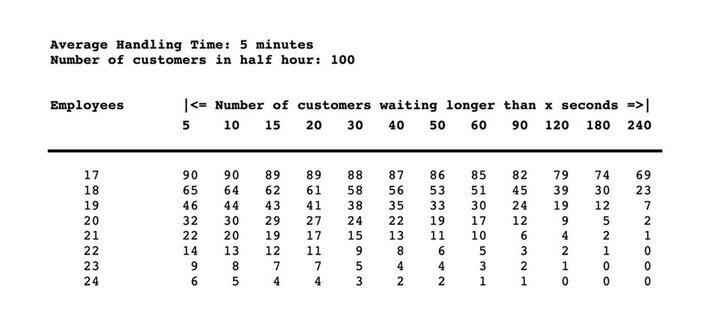By
Brad Cleveland
|
Date Published: August 31, 2021 - Last Updated September 06, 2021
|
Comments

As customers, we’ve seen the signs posted in retail and restaurants: “Please be patient with our team.” We’ve heard similar delay announcements when contacting other organizations: “Due to unusually heavy demand...” But if you’re a contact center manager, there’s a good chance you’re also on the other end of these challenges—the one tasked with resolving them in your own operation
Supply and production issues are, as Carrington York put it in a recent LinkedIn News story, “flipping the U.S. economy on its head.” And customer service operations are in the middle of the storm.
As a customer service leader, what can you do? I want to suggest four steps that can help.
1. Establish simple, effective quality standards
Labor shortages in contact centers are often viewed as a matter of keeping up with workload. What’s often missed is how to respond to the nature of the workload. You can throw all the resources at it that you want, but if your organization isn’t prepared to handle the content of the work, it’s going to be a struggle.
This is where empowerment is so important. Many organizations want to do the right thing for customers, but too often put a multi-layered, time-eroding approval process in place to get there. Your employees must be able to take action as circumstances unfold.
Many executives are initially concerned with empowering employees to make decisions that could cost the organization, but empowerment done right is efficient and cost-effective. Employees appreciate the trust and want to make decisions that are right for customers and the organization. And because it’s happening on the spot, you are saving resources and aggravation for all involved.
The key is to have clear standards and guidance. Here are the kinds of questions each employee should be equipped to answer:
- What would resolve the problem for this customer?
- What decision best aligns with our values and mission?
- How should I best capture information and learnings about this issue so that we are equipped as an organization to make improvements going forward?
Training and coaching should be focused on these questions. Create scenarios and role plays that strengthen judgment and decision-making skills. You won’t be able to anticipate and train on every situation that comes along, but you can provide a foundation that leads to good decisions, no matter the circumstances.
2. Tap the potential of your team to innovate
What’s the chance you can eliminate or minimize entire categories of work? A large consumer products company was struggling with high turnover and staffing shortages in a customer service department. Customer feedback was awful, the culture was stifling, and employees jumped at any chance to move to other jobs.
But as their new director would discover, his team would have answers. They just needed to be drawn out. He began an initial meeting by asking them about their value and purpose. One employee, arms folded, responded with a question: “We handle consumer gripes all day. How important can that be?”
They decided to find out. Some simple analysis over the next few days revealed that many of the customer contacts about a popular cleaning product were due to the cap being too hard to remove. Customers would force it off, too often shearing off the spray nozzle. They shared this data with their packaging supplier, who redesigned the caps. Those contacts went away, reducing workload and benefiting many future customers.
That gave the team a glimpse of their potential. In the weeks and months that followed, the department became involved in marketing, systems improvement, and product development. A senior leader told me that team had become the “secret sauce” to the company’s research and development. Employees became engaged and excited, and turnover dropped to single digits.
I cite this story often because if they can do it—if a consumer products company with relatively simple products and support can tap that depth of innovation—anyone can. If there’s ever a time we need innovation working for us, it’s now
3. Educate everyone on the “power of one”
Employees have an impact that goes far beyond the customers they directly help. Consider a group of 20 employees who are helping 100 customers over a 30-minute period of time. (I produced a table of predictions based on the formula Erlang C. Erlang C predicts staffing requirements when customer queues are involved—retail stores, contact centers, restaurants, or others. There are many simple, free Erlang C calculators; here, I’m using ICMI’s QueueView calculator.)
With 20 team members, 32 customers wait five seconds or longer. As things play out (just glance along that row from left to right), 30 customers are still waiting ten seconds or longer, 29 are still waiting 15 seconds or longer, and so forth. You can see that a couple of customers wait 240 seconds (4 minutes) or more.
Figure: Example of a Customer Queue

What happens if you have only 17 employees? Woah! Dozens of customers are waiting four minutes or longer. Look at the results when you have just one more person who jumps in and helps out. You’ve seen that dynamic in busy grocery stores; when they open one more checkout lane, all the lines shift around and everything moves more quickly.
Each employee has a significant positive impact on customer wait times—a ripple effect far beyond the customers they serve directly. Include this principle in training and coaching—knowing about it can lead to a powerful, ground-up understanding of the importance of timing and of each person’s impact on customers and colleagues.
4. Give customer experience a renewed push
As a rule, what is best for customers is most effective for your organization from a resource perspective. As you harness tools to better identify customers and what they need, you can pull up the right information, get them to the right places, automate or prevent steps or entire interactions, and handle that work so that it’s once and done. The steps you take to make things easier for customers often creates efficiencies for your operation.
We all got a sense of what’s possible when we were forced to move teams to work from home early last year. While few would want to relive the pressures and urgency of those weeks, there’s a silver lining: the teams, cross-functional cooperation, and priorities that came out of that effort can be a good template for next steps in your digital transformation initiatives. Tackling the current labor challenges is an urgent and golden opportunity to better position your operation for the future.
These steps can help you navigate current labor shortages. Long term, they deliver much more. By boosting innovation and empowerment, you’ll be strengthening your organization far beyond simply surviving today’s challenges.